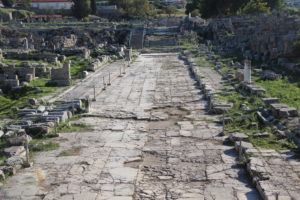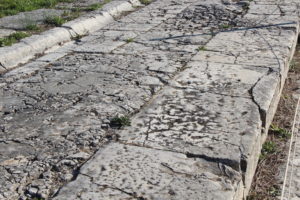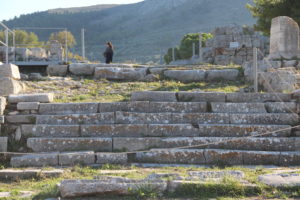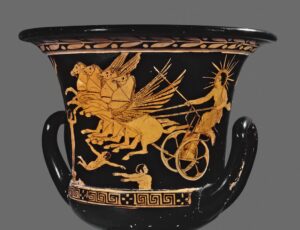[2] ἐκ δὲ τῆς ἀγορᾶς ἐξιόντων τὴν ἐπὶ Λεχαίου προπύλαιά ἐστι καὶ ἐπ᾽ αὐτῶν ἅρματα ἐπίχρυσα, τὸ μὲν Φαέθοντα Ἡλίου παῖδα, τὸ δὲ Ἥλιον αὐτὸν φέρον. ὀλίγον δὲ ἀπωτέρω τῶν προπυλαίων ἐσιοῦσιν ἐν δεξιᾷ ἐστιν Ἡρακλῆς χαλκοῦς. μετὰ δὲ αὐτὸν ἔσοδός ἐστι τῆς Πειρήνης ἐς τὸ ὕδωρ. ἐπὶ δὲ αὐτῇ λέγουσιν ὡς ἥ Πειρήνη γένοιτο ὑπὸ δακρύων ἐξ ἀνθρώπου πηγή, τὸν παῖδα ὀδυρομένη Κεγχρίαν ὑπὸ Ἀρτέμιδος ἀκούσης ἀποθανόντα.
- Map
- Pre Reading
- Post Reading
- Culture Essay
After completing his discussion of the agora, Pausanias now embarks on describing Corinth along three different routes that move out of the agora radially like spokes on a wheel. The first is the road north to Lechaeum, the second is the road west to Sicyon, and the third is the road south up to Acrocorinth.
After passing through the Propylaia—marked by statues of Phaethon and his father Helios—toward Lechaeum, Pausanias immediately speaks of the most famous fountain in Corinth, Peirene. As he continues down the road to Lechaeum, he writes most extensively about baths and the aqueduct built to feed them. It appears that Hadrian vies with Poseidon as a benefactor of these waterworks.
N/A
Arch at the Head of the Lechaion Road (Corinth Computer Project)



